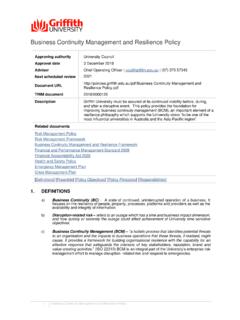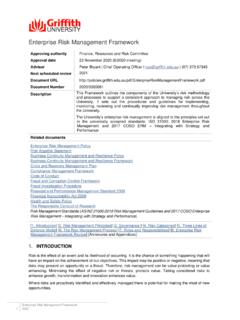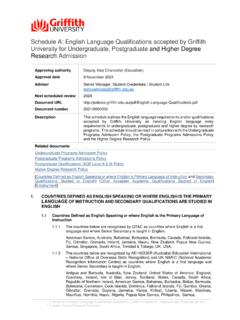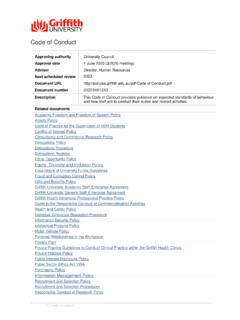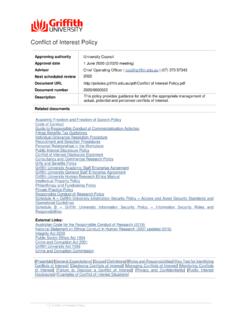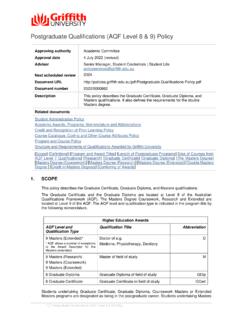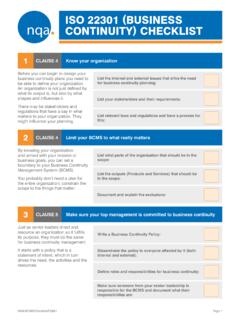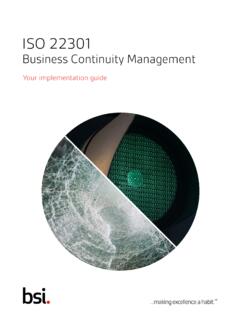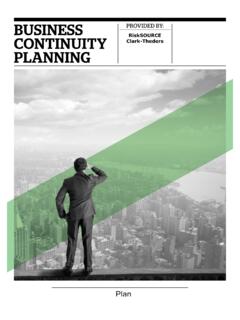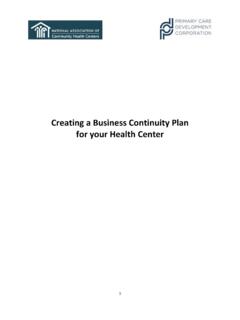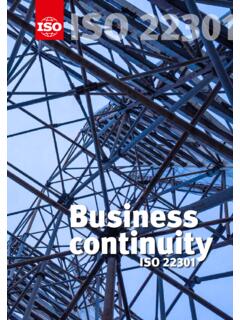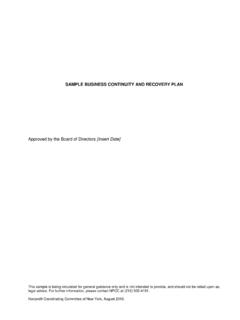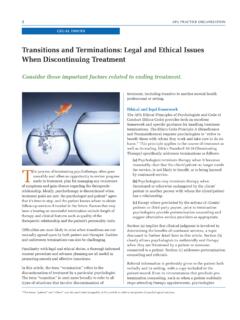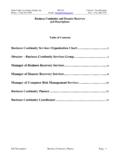Transcription of Business Continuity Management and Resilience Framework
1 1 Business Continuity Management and Resilience Framework Business Continuity Management and Resilience Framework Approving authority University Council Approval date 3 December 2018 Advisor Chief Operating Officer | (07) 373 57343 Next scheduled review 2021 Document URL Continuity Management and Resilience TRIM document 2018/0000142 Description This Framework sets out the approach, processes and procedures for managing the University s Business Continuity and Resilience to protect against disruptive events. Related documents Business Continuity Management and Resilience Policy Risk Management Policy Risk Management Framework Financial and Performance Management Standard 2009 Financial Accountability Act 2009 Health and Safety Policy Emergency Management Plan Crisis Management Plan [Introduction] [Purpose of the Business Continuity Management and Resilience Framework ] [What is Business Continuity Management ?]
2 ] [The Business Continuity Approach] [Link between Emergency, Crisis and Disaster Recovery Planning] [Roles and Responsibilities] [Communication] [ Framework , Maintenance and Assurance] [Glossary] 1. INTRODUCTION Business Continuity Management (BCM) is an integral part of the University s approach to effectively managing risk. This Framework defines the BCM methodology and Continuity planning process for managing disruption-related risk. The BCM Framework is underpinned by the Business Continuity and Resilience Policy. The Policy defines Continuity and recovery principles against which its capability can be audited. This Framework and methodology is based on Standards AS/NZS 5050:2010 Business Continuity Managing disruption-related risk and ISO 22310 Societal security Business Continuity Management systems.
3 2. PURPOSE OF THE Business Continuity Management AND Resilience Framework The purpose of this Framework is to inform and drive continual, effective, cross-functional, multi-level Continuity planning through holistic, integrated risk Management practice in the following ways: 2 Business Continuity Management and Resilience Framework Establish a control environment to link corporate governance, risk Management , Business planning and operational performance to the University strategic direction ( Business Continuity programme); Invest time, capital, tools and techniques to ensure BCM is a fully embedded, auditable Business Management process ( Business Continuity planning); Provide senior managers with opportunities to obtain a sound understanding of Business Continuity Management and requisite skills to implement Business Continuity effectively; Ensure the Framework is sufficiently flexible to meet the challenges of scalability, different University Business profiles and various geographic needs coupled with governance, regulatory and legal regimes; Assist and manage events that require information and resource coordination across multiple Business functions and/or campuses (Crisis Management Planning); and Uphold a Resilience philosophy in which the University Business Continuity capability always reflects the needs, technology, structure and culture of its Business .
4 3. WHAT IS Business Continuity Management ? Business Continuity (BC) refers to a state of continued, uninterrupted operation of a Business . It focuses on the resiliency of people, property, processes, platforms and providers as well as the availability and integrity of information. Disruption refers to an outage which has a time and Business consequence dimension but does not include operational glitches which are managed through standard operating procedures. Disruption results from an event which interrupts Business -as-usual critical processes or operations whether anticipated or not. When it comes to Business disruption, it is not a matter of if, but when, how, and how severe. Disruption-related risks may be infrequent, but could have severe consequences for critical services, which are not able to be resolved by routine Management .
5 Disruption-related risks include physical and non-physical events, such as, natural disasters, pandemics, significant loss of utilities, financial crises, accidents, and incidents that threaten our reputation. BCM is the development, implementation and maintenance of policies, strategies and programs to assist the University to manage a Business disruption event, as well as build Resilience . It is the capability that assists in preventing, preparing for, responding to, managing and recovering from the impacts of a Business disruption event. BCM is an application of risk Management , an integral component of sound corporate governance and an important aspect of emergency preparedness and operational Resilience . An effective BCM will safeguard the University s core functions and associated expectations of key stakeholders, assist the University meet legal, regulatory and contractual obligations and protect its reputation.
6 The objectives of BCM are to: Keep people safe; Reduce the University s vulnerability to future Business discontinuity; Protect vital assets owned by the University and those assets belonging to others for which it carries responsibilities; Protect intellectual assets and contracts that place the University in a value chain through suppliers and distributors; Preserve the ability to meet stakeholder expectations in a wide range of circumstances, including meeting 3rd party arrangements; Reduce reliance on key personnel; Provide for an orderly and expedited recovery after a disruptive event; and Maintain or gain competitive advantage due to a swift and effective response The key functional elements of BCM are outlined below. 3 Business Continuity Management and Resilience Framework 4.
7 THE Business Continuity APPROACH Business Continuity Planning (BCP) is a function within BCM. The approach for BC is a continuous planning and preparing process of identifying hazards and University vulnerabilities, the likelihood of disruption, potential consequence on time-sensitive objectives and strategic success, existing control effectiveness and options and strategies to improve performance and efficiency. It considers risk over time when usual work areas, staff, assets or processes are not available. Key concepts of the BC approach are: Understand the Business - To develop a BCP, a thorough understanding of the Business is required. This involves defining the Business mission and time-sensitive objectives, identifying critical process inputs and outputs and functional dependencies, prioritising process and resource requirements and determining external supply and contractual arrangements; Assess the risks - Risk assessment is the primary activity in the production of a BCP.
8 The identification, analysis and evaluation of risk is the important early step to understand the probability and potential consequence and associated problems from Business disruption, determine risk appetite and scope the need for a BCP; Prepare a BCP - The primary output of the BC process is a BCP, which is a pre-defined, pre-tested, Management approved communication and decision support tool. The plan is executed in response to a Business disruption; Test the plan - In the event of a Business disruption, relevant staff must understand what is expected of them. Staff with BCP responsibilities should regularly rehearse their roles to test the BCP practicality, validate its currency, confirm their competence and confidence and test their assumptions around access to resources.
9 The BC planning process is geared towards providing University Council, as well as University stakeholders, assurance that if the worst happens the University has the capacity to recover quickly, safely and as cost effectively as possible. The BCM approach will also involve the integration of the disciplines of: Emergency Management (People and property issues); 4 Business Continuity Management and Resilience Framework Crisis Management (Corporate issues); Business Continuity Planning (Process contingencies); Disaster Recovery (IT system and data availability). Committing to a University risk-based BC approach will enhance understanding of disruption-related risk, Continuity planning and response Management and increase staff vigilance and competency to work around Business disruption until full functionality is restored or a new mode of operation implemented.
10 5. THE Business Continuity PROCESS The illustration below demonstrates the roadmap for the Business Continuity process 5 Business Continuity Management and Resilience Framework Step 1: Risk Identification and Business Impact Analysis Risk Identification The initial analysis provides the understanding of: University s core Business functions; Critical processes; Assets (anything of material value or usefulness); Extent of the contribution of each asset; Exposure and susceptibility or processes and assets to interruption. Senior Management will: Identify threats (hazards) to core Business function Continuity and the processes, systems, information, people, assets, outsource partners and other resources that support or rely on them; Systematically analyse the likelihood and consequence of disruption and rate using the consequence ratings in the risk Management Framework ; Evaluate which disruption-related risks require treatment; and Identify treatments commensurate with BC objectives and in accordance with the University s risk appetite.
